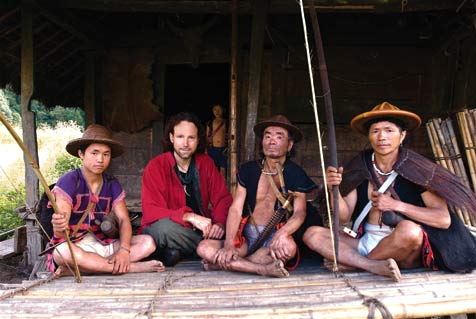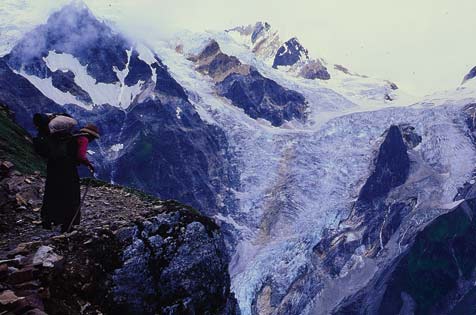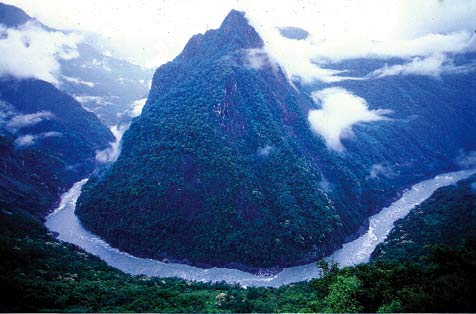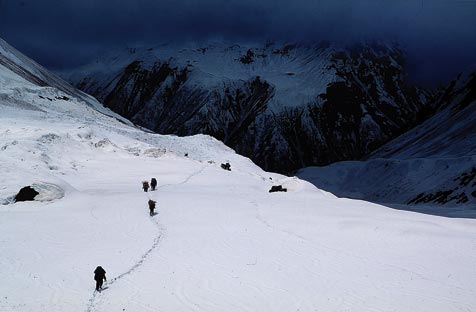Author and Adventurer Ian Baker to Speak About His Travels in Tibet
A Journey to the Heart of the World

In today’s world, most parts of the globe have been visited, described, and documented. However, there are still a few blank spots on the map, and people have always sought to conquer these last vestiges of frontier. One such place is a fabled waterfall hidden deep within the gorge of the Tsangpo River in Tibet. From the early 19th century and into the 20th century, British explorers-coming from their territories in India to learn more about the forbidden land to the north-sought the reason for the 11,000 foot drop in elevation between the origins of the Tsangpo River and the lower reaches of the same riparian corridor in Assam, which is now part of eastern India.
In order to gain information about the Tsangpo River and its gorges, the British government sent surveyor/spies to find out if Tibet’s Tsangpo and the Brahmaputra River in Assam were in fact the same river. After some harrowing brushes with Assamese tribesmen and the Tibetan government’s generally unfriendly treatment of Westerners who they thought might be trying to exploit them, the Brits were able to ascertain that the two rivers were in fact one and began in earnest a search for the legendary falls. Although none of the British explorers were able to access these farthest reaches of the gorges or find the waterfall after more than a century of searching for it, they conceded that its existence was a possibility.

That is what led Ian Baker, an American writer, adventurer, and student of Buddhist religion, to pick up the torch and continue the quest for the hidden falls. “It was these accounts that sounded like something out of Lord of the Rings that really got my imagination at the time,” said Baker. His experiences were the basis for the book The Heart of the World: A Journey to the Last Secret Place-which includes an introduction by the Dalai Lama and is one of several books that Baker has written.
Baker was not the first in his family to engage in extreme exploration and adventure. As a boy, he was regaled with tales of his forebears, including his great grandfather-William Edgar Baker-who surveyed a path through the Rocky Mountains for the Canadian Pacific Railway from 1881 to 1883. He learned to climb with his stepfather, who recently crossed Greenland on skis and is currently preparing to climb Mount McKinley. “There is a long family history of exploration and adventure on both sides,” he said. “My family was immensely supportive of my exploration of Pemako.”

Baker’s destination, the Tsangpo Gorges-the deepest in the world-are thought by Buddhists to contain several entrances to an earthly paradise. The fabled waterfall is one such portal, and according to Tibetan texts, the only way to reach both the physical and spiritual realms is through great hardship. The area where the waterfall was thought to exist is called Beyul Pemako, or “the hidden land shaped like a lotus.” Having lived mostly in Nepal since graduating from college in the United States, Baker embarked on eight separate forays into the Tsangpo Gorges, using information collected by British explorers in conjunction with Tibetan Buddhist texts to find the reputed location of the falls.
In November 1998, after overcoming many obstacles imposed by the restrictive Chinese government, which had taken over Tibet from the Dalai Lama in 1959, Baker led a National Geographic-sponsored expedition into the gorges of lower Pemako. It was then, using the latest climbing gear, that Baker and his team were able to rappel into the deepest gorge and measure the falls. According to the data they collected, the falls measure 108 feet in height. “It was amazing finding a place that had been written off as a myth,” he said. “It’s the world’s deepest gorge, and to be standing where we were standing was a very powerful experience. It was a place where myth and reality came together.”

Baker maintains that although his journey was physically challenging, it also held spiritual significance. “From a Western point of view, just reaching this blank spot on the map would be sufficient,” he said, “but in terms of what it means to open the door to that sacred place is more in line with Tibetan prophecies. Opening the door to a hidden land is meant to bring about a fundamental change of consciousness for the world as a whole.” Baker contrasts the Western concept of a paradise lost, noting that Tibetan texts place earthly paradise at the end of history. “This is an alternative perspective that the West can learn from,” he said. However, he also asserted that according to Tibetan prophecies, it would take a pilgrimage by someone with a very deep spiritual understanding -such as reincarnations of the great lamas of the past -to be able to unlock the metaphorical door to a momentous change in global consciousness.
Aside from being the first to reach this legendary hidden land, Baker counts his achievement as a narrowing of the gap between the physical world and the spiritual. “There’s a hidden land in the way that we as human beings relate to each other,” he said, “culturally and with respect to greed and power. When we search to open that hidden land within ourselves, in a way we fulfill the prophesies of an earthly paradise-not only in the Buddhist tradition but in the Western tradition of Eden as well.”
4•1•1
Ian Baker will speak at the Unity Church on Friday, April 11, at 7 p.m. The lecture is presented by the Vairotsana Foundation, and all proceeds will benefit the organization’s Stupa Project for Universal Peace. A $15 donation is suggested.



